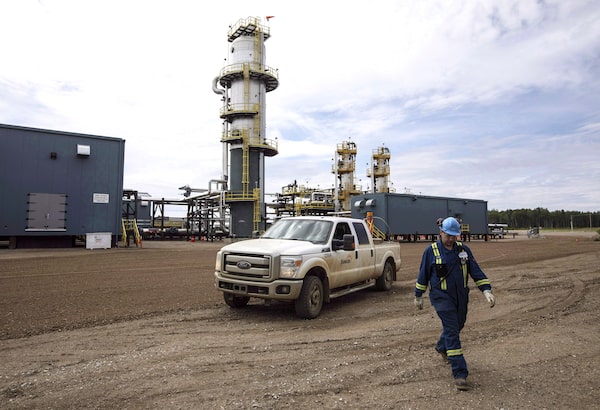
Cary Walton, Suncor operations manager, MacKay River, walks around a group separator on a Suncor site in the oil sands in Fort McMurray Alta., on June 12, 2017.JASON FRANSON/The Canadian Press
Canada’s oil and gas industry is asking the federal government to increase its planned tax credits for carbon capture projects, so the country is able to keep pace with new credits introduced in the United States as part of the Biden administration’s Inflation Reduction Act.
Failure to do so, industry figures say, could put Canadian companies that want to invest in emissions-reducing technology at a competitive disadvantage.
The sweeping US$430-billion U.S. bill, signed by President Joe Biden on Aug. 16, earmarks US$369-billion for climate and energy programs, and represents the U.S.’s largest single investment in combatting climate change. The act increases the country’s existing carbon capture tax credit, called 45Q, by 70 per cent, to US$85 for every metric ton of carbon emissions captured and stored. Captured carbon can be injected underground in order to prevent it from being released into the atmosphere, where it would contribute to climate change.
The U.S. legislation also extends the tax credit to projects that would previously have been too small to qualify. And it offers credits of as much as $180 a ton to direct-air capture projects, which suck up emissions that have already been released into the atmosphere.
Mark Cameron, the vice-president of external communications at Pathways Alliance, an industry group that is working toward achieving net-zero emissions in Alberta’s oil sands by 2050, said Ottawa’s planned tax-credit regime is a significant step forward in federal support for emissions-reducing technology. But he warned that the domestic carbon capture industry could suffer if Canada’s credits aren’t as generous as those in the U.S.
“We think the government has to look at what is happening with 45Q and the Inflation Reduction Act to see whether we’re still cost competitive with the United States,” he said.
“It’s just really important for us to remain competitive with our largest trading partner and largest competitor in this space.”
Carbon capture and storage: The dreams and setbacks in climate action
Just days before the changes in the U.S., Ottawa released the final details of its impending carbon capture investment tax credits.
The Canadian tax credits will cover 50 per cent of capital expenses for most carbon capture and storage (CCS) projects through 2030.
The U.S. tax credit, on the other hand, equates to about 85 per cent of project expenses, which is similar to the rate in Norway.
The Canadian Ministry of Finance did not return a request for comment on whether it is preparing to review the government’s level of support for CCS.
Jan Gorski, director of the oil and gas program at the Pembina Institute, a think tank, said it’s hard to draw a direct comparison between the Canadian and U.S. carbon capture programs.
That’s because the U.S. is focused on incentives, he said, whereas Canada has a more nuanced approach, with a mix of both incentives and regulations, such as carbon pricing and clean fuel standards.
“I think that we actually need a mix of both,” Mr. Gorski said. “It’s critical to drive down emissions within the oil and gas sector, but also to create incentives for other sectors to invest in CCS as well.”
Canada has for years been a leader in CCS and is home to five of the world’s 27 operational carbon capture projects.
Yet some in the CCS sector worry that failing to boost fiscal support for the technology in Canada will result in investments being drawn south of the border not just in oil and gas, but also in other industries – such as cement, steel, petrochemicals and fertilizers – where CCS is expected to play a critical role in reducing emissions.
James Millar, chief executive of the Saskatchewan-based CCS Knowledge Centre, said he believes Canada needs to take “a good, hard look” at CCS measures in the Inflation Reduction Act, and respond accordingly.
“Countries such as the U.S., the U.K. and Norway, they have significant CCS incentives in place, and ignoring this puts Canada at a great disadvantage to our peers, to our competitors,” he said.
“We run the risk of losing green investment and credibility with the global community.”
Mr. Millar acknowledged that companies need to make investment decisions that “go beyond the balance sheet” to help fight climate change. But he said government subsidies still play an important role.
“We all need to do the right thing. But we are doing this in a construct where we are talking about companies that do have to report to boards and do have to report to leadership and shareholders,” he said.
“I do believe that there is a responsibility to do this, but let’s incentivize the responsibility. Let’s try to meet in the middle here to get it done.”
Brad Herald, vice-president of Western Canada operations with the Canadian Association of Petroleum Producers, said the new measures under the Inflation Reduction Act will “trigger a wave of private sector capital” that will help decarbonize U.S. oil production.
And if Canada doesn’t up its game, “it’s not hard to see us being laggards in that race,” he said.
“If the end goal here is to design an industrial policy to elicit a response from private sector capital to really get these projects underway and advance the decarbonization opportunity, you have to put a package together that makes these projects economic, gets the level of investment.”
Your time is valuable. Have the Top Business Headlines newsletter conveniently delivered to your inbox in the morning or evening. Sign up today.
 Emma Graney
Emma Graney